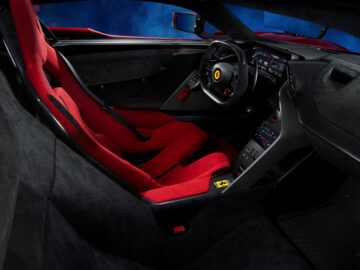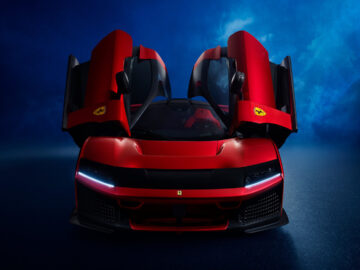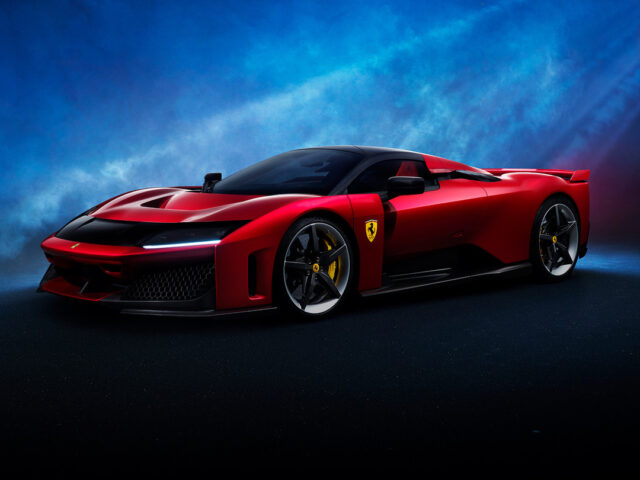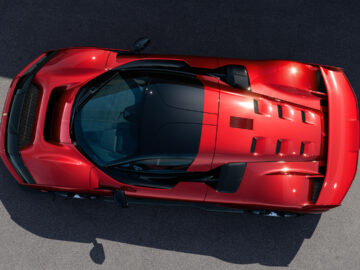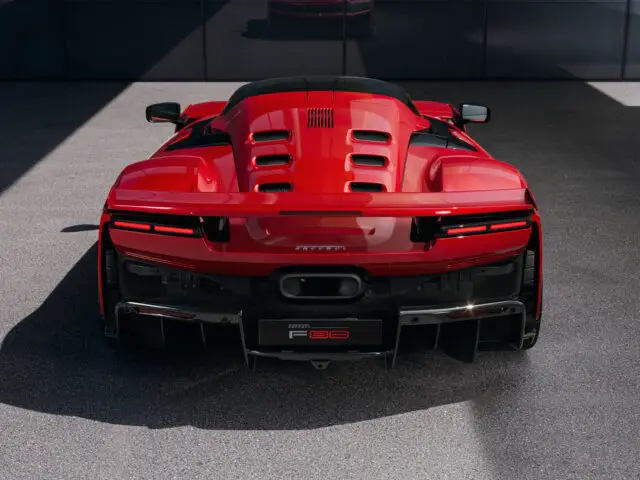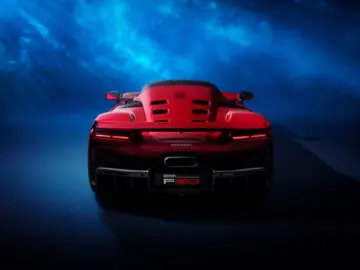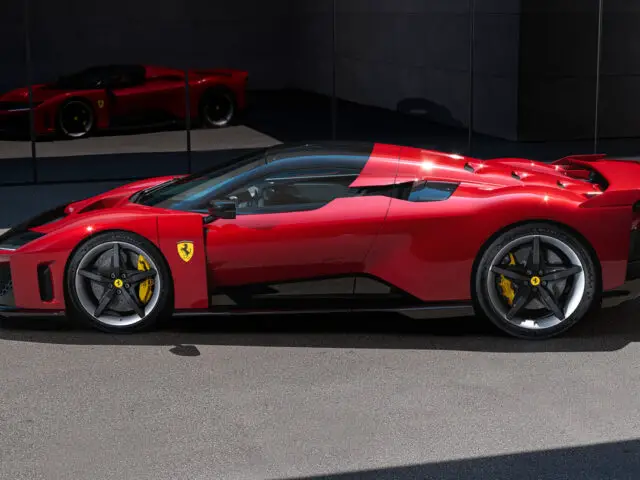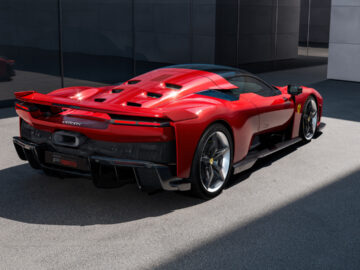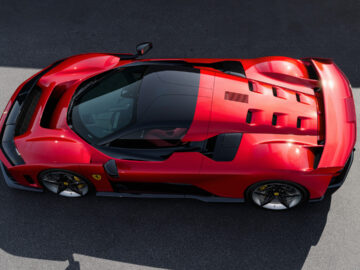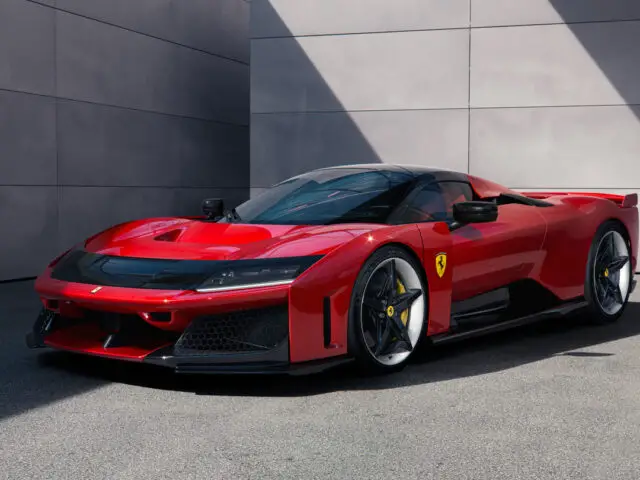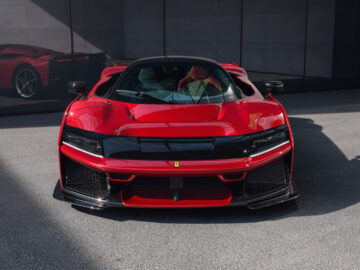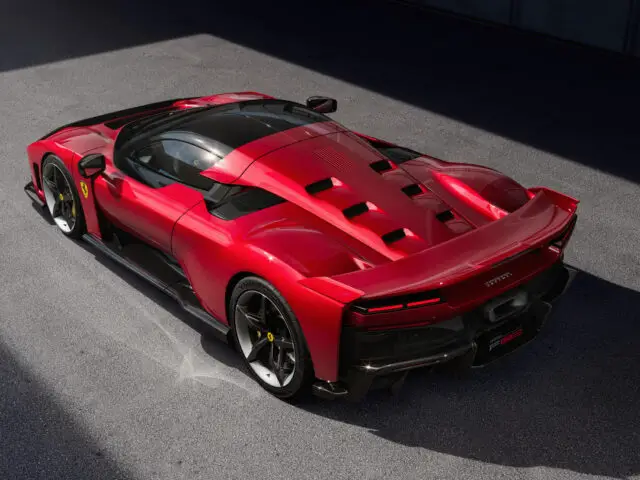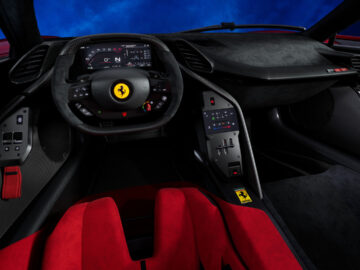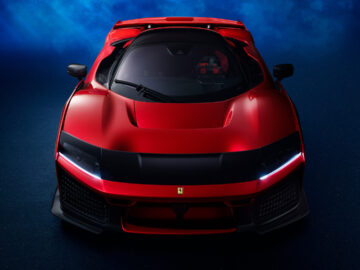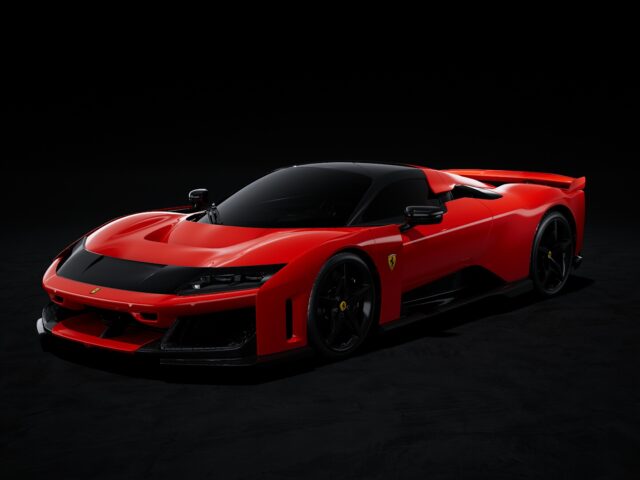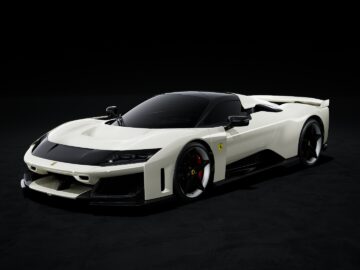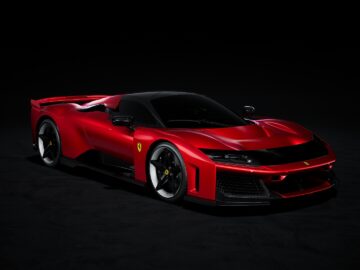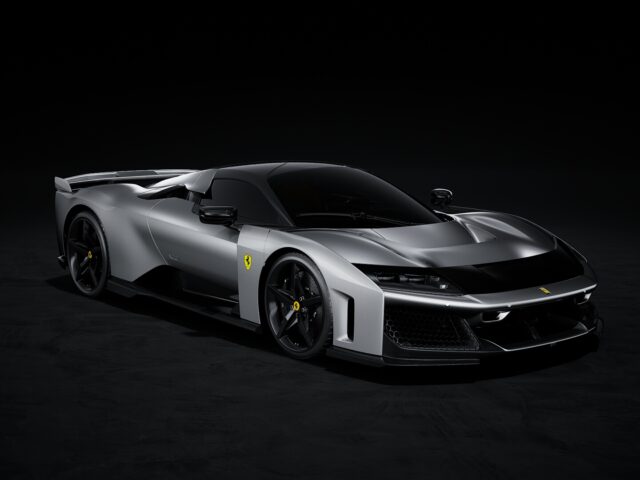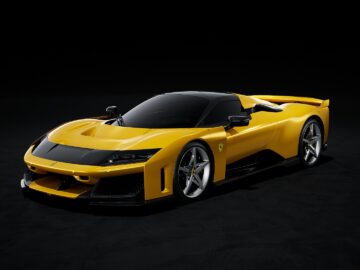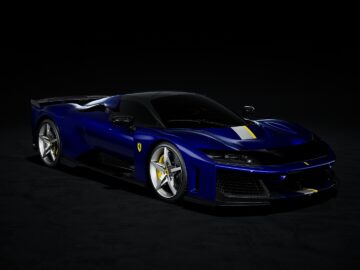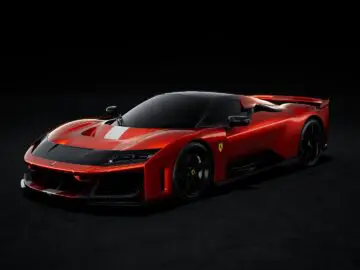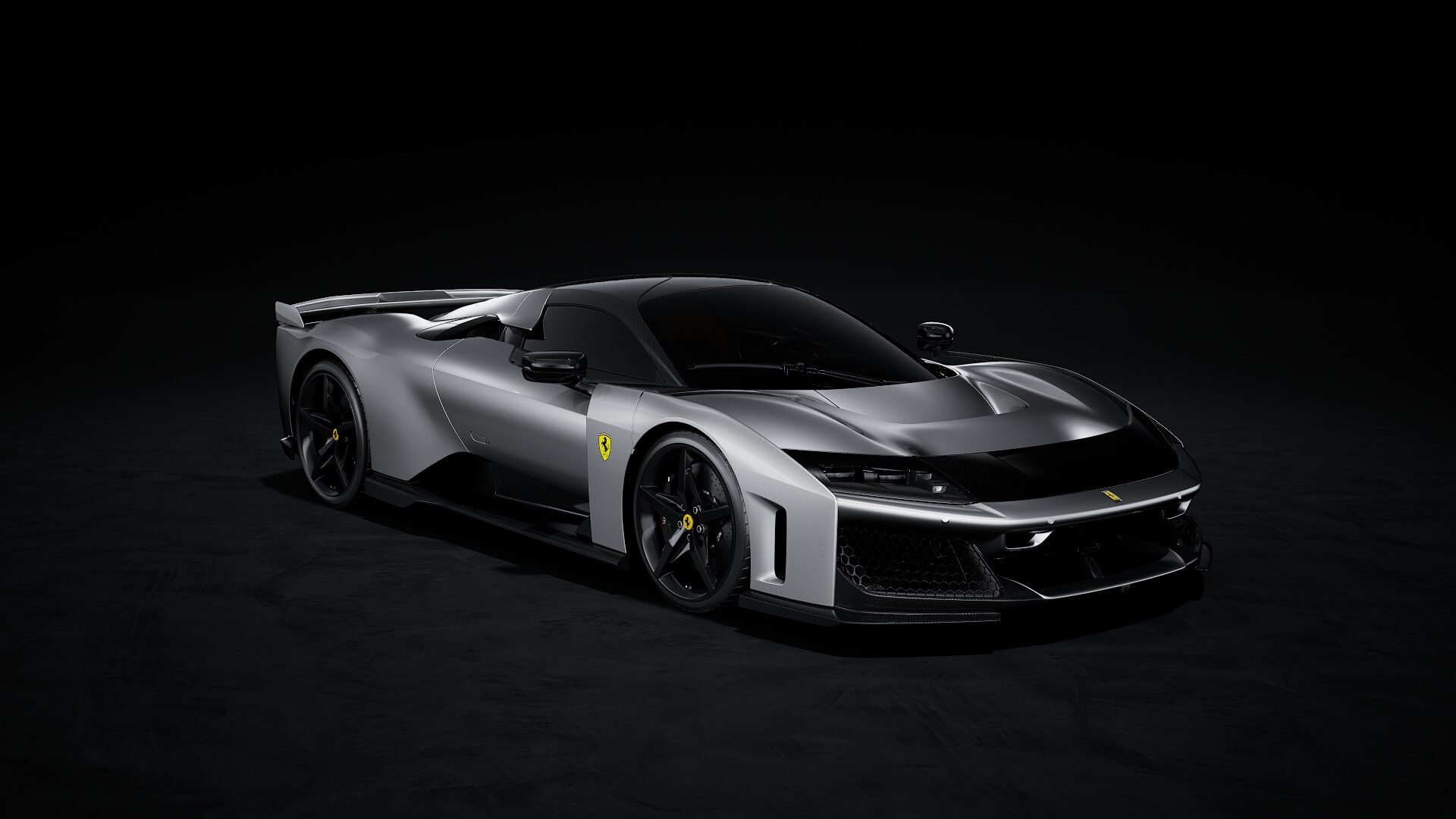Ferrari F80: with 1,200 hp the most powerful Ferrari ever
Ferrari F80 impresses
A 0-100 time of just 2.15 seconds, 0-200 in 5.75 seconds, a top speed of 350 km/h, a 900-hp 2,992 cc V6 with 120-degree block angle, complemented by electro-power: the Ferrari F80 is a car that already impresses a lot on paper. And then you have to go see the car. You will literally be blown away.
Smart electrical engineering
The powertrain of the Ferrari F80 uses the first electric motor (MGU-K) developed, tested and manufactured entirely by Ferrari in Maranello. A DC/DC converter transforms direct current of one voltage to direct current of another voltage. This single component simultaneously handles three different voltages: 800 V, 48 V and 12 V.
The front axle, also completely developed and produced in-house by Ferrari, includes two electric motors, an inverter and an integrated cooling system. This component makes it possible to apply torque vectoring for the front axle. The integration of several functions into one component and the new mechanical layout have resulted in a weight saving of about 14 kg compared to previous applications.
Optimizing mechanical efficiency was a primary goal: low-viscosity oil and an active dry-sump lubrication system with an oil tank integrated directly into the shaft reduced mechanical power losses by 20%. The use of high-coverage gears helped reduce noise emissions by 10 dB.

Rear electric motor
The inverter integrated in the front axle also converts the alternating current produced by the axle during regenerative braking into direct current for charging the battery. Another inverter is used for the rear electric motor (MGU-K), which performs three functions: starting the combustion engine, recovering energy to charge the high-voltage battery, and supplementing the engine’s torque in certain dynamic conditions.
Integrated into both inverters is the Ferrari Power Pack (FPP) system, a power supply module with all the elements needed for power conversion, combined in the most compact unit possible. The high-voltage battery is designed for very high power density.
Battery of 2.3 kWh
The battery pack is configured with 204 cells connected in series and evenly divided into 3 modules, for a total energy capacity of 2.3 kWh and a maximum output of 242 kW.
Aluminum subframe
The fairing and other elements of the F80’s chassis were developed using a multi-material approach, with each individual area using the material best suited to the task. The cell and roof are made of carbon fiber and other composites, while the front and rear subframes are aluminum and attached to the fairing with titanium screws. At the rear is an additional aluminum subframe, attached to the main rear subframe with screws, to carry the battery.
Wink to Ferrari F40
The F80 has a strong futuristic visual impact with unmistakable references to aerospace. The architecture is defined by a two-plane cross section whose two lower corners are firmly placed on the wheels. From the side view, the rear has a sculpted line that emphasizes the muscularity of the entire rear wing. The front part of the car is defined by more architectural elements: the wheel arch ends with a vertical panel that stands proudly on the door and pays homage to the imagery of the F40.
Interior
The interior puts the focus on the driver, who gets to sit on a red bucket seat. The passenger is “sideshow,” although he or she will probably get the drive of a lifetime as well. The interior also bears some resemblance to the cockpit of an F40. Superfluous items have been left out. In the F80, it’s all about driving. By the way, the car costs 3.6 million euros. Production is limited to 799 units.
Ferrari F80 – technical data
INTERNAL COMBUSTION ENGINE (ICE)
- Type: V6 – 120° – dry sump
- Total displacement: 2992 cc
- Bore and stroke: 88 mm × 82 mm
- Maximum power: 900 cv at 8750 rpm
- Maximum torque: 850 Nm at 5550 rpm
- Maximum engine speed: 9000 rpm (dynamic limiter at 9200 rpm)
- Compression ratio: 9.5:1
- Specific power output: 300 cv/l
HYBRID POWERTRAIN
- Type: Concentrated winding stator, Litz wire and stator and rotor in a Halbach array configuration
REAR ELECTRIC MOTOR (MGU-K)
- Operating voltage: 650 – 860 V
- Peak power: Regenerative braking: 70 kW (95 CV); ICE assist: 60 kW (81 CV)
- Peak torque: 45 Nm
- Maximum engine speed: 30,000 rpm
- Weight: 8.8 kg
FRONT AXLE ELECTRIC MOTOR
- Operating voltage: 650 – 860 V
- Peak power: 105 kW (142 CV) for each of the two electric motors
- Peak torque: 121 Nm
- Maximum engine speed: 30,000 rpm
- Weight: 12.9 kg
HIGH-VOLTAGE BATTERY
- Maximum voltage: 860 V
- Maximum power (charge/discharge): 242 kW
- Energy: 2.28 kWh
- Maximum current: 350 A
- Power density: 6.16 kW/kg
- Weight: 39.3 kg
WEIGHTS AND DIMENSIONS
- Length: 4840 mm
- Width: 2060 mm
- Height (in kerb weight conditions): 1138 mm
- Wheelbase: 2665 mm
- Front track: 1701 mm
- Rear track: 1660 mm
- Dry weight: 1525 kg
- Dry weight/power ratio: 1.27 kg/cv
- Weight distribution: 42.2% front / 57.8% rear
- Fuel tank capacity: 63.5 litres
- Luggage compartment capacity: 35 litres
TYRES AND WHEELS
- Front: 285/30 R20
- Rear: 345/30 R21
BRAKES
- Front: 408 x 220 x 38 mm (6 pistons per calliper)
- Rear: 390 x 263 x 32 mm (4 pistons per calliper)
TRANSMISSION AND GEARBOX
- 8-speed dual-clutch F1 DCT
- ELECTRONIC CONTROLS
- SSC 8.0: TC, eDiff, SCM, PCV 3.0, FDE 2.0, EPS, ABS-Evo in all Manettino modes, 6D sensor
- performance ABS/ABD
PERFORMANCE
- Maximum speed: 350 km/h
- 0–100 km/h: 2.15 s
- 0–200 km/h: 5.75 s
- 100-0 km/h: 28 m
- 200-0 km/h: 98 m




